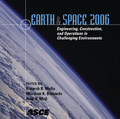Optimal Evolutionary Computational Parameters for Habitat Structures Optimization
Publication: Earth & Space 2006: Engineering, Construction, and Operations in Challenging Environment
Abstract
Long-duration surface missions to the Moon and Mars will require bases to accommodate habitats for the astronauts, as well as indoor laboratory facilities, in-situ resource plants, power plants, and scientific/surface mobility equipment. Transporting the materials and equipment required to build the necessary habitats would be costly and difficult. However, the use of planetary resources to produce construction materials, or even as naturally found (such as lunar regolith utilized as an outer layer for radiation shielding, or regolith in bags as wall structure), could drastically reduce the upmass for habitats. The materials chosen for the habitat walls play a direct role in protection against each of the mentioned hazards. Choosing the best materials, their configuration, and the amount required is extremely difficult due to the immense size of the design region. For example a 3-layer habitat wall created from 20 possible materials all with varying thicknesses would have #number of layers(possible material types)∧(possible thicknesses) = 320∧inf possible solutions. Clearly, an optimization method is warranted for habitat wall design. Standard optimization techniques are not suitable for problems with such large search spaces. To overcome the large search regions, a habitat wall design tool using genetic algorithms has been developed. GAs use a "survival of the fittest" philosophy, where the most fit individuals are more likely to survive and reproduce, therefore transmitting their genes to the next generation. This paper focuses on finding optimal GA parameters for the habitat optimization tool. This tool is a multiobjective formulation of structural analysis, heat loss, radiation, and meteoroid protection. Some of the constraint calculations (i.e. safety factor, deflection, and heat loss) require long computation times. Even though each material has a designated thickness range, the number of different values within that range is near infinite; therefore, the search space is infinite. Both of these concerns make a more efficient genetic algorithm optimization very appealing. The effect of varying the genetic algorithm parameters (population size, mutation rate, etc.) to find a suitable GA parameter set for this tool will be analyzed and presented here. This produces a higher fidelity of analysis and quicker run times.
Get full access to this chapter
View all available purchase options and get full access to this chapter.
Information & Authors
Information
Published In
Copyright
© 2006 American Society of Civil Engineers.
History
Published online: Apr 26, 2012
Authors
Metrics & Citations
Metrics
Citations
Download citation
If you have the appropriate software installed, you can download article citation data to the citation manager of your choice. Simply select your manager software from the list below and click Download.
